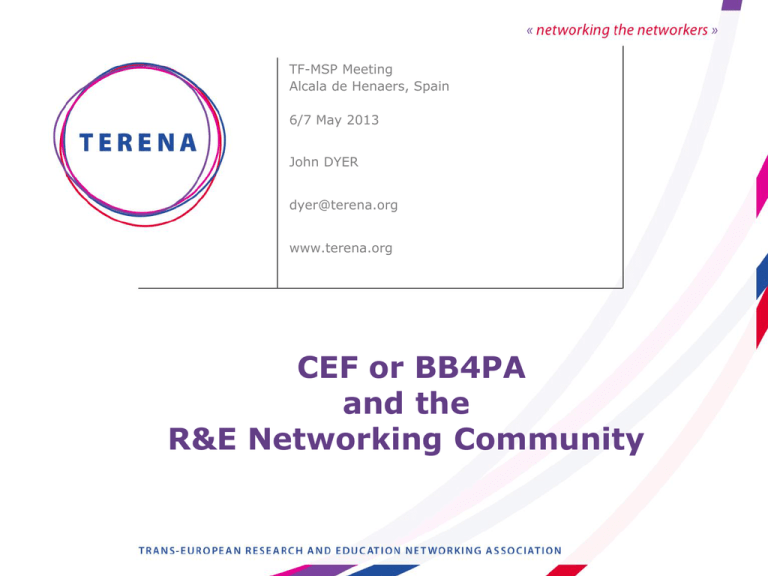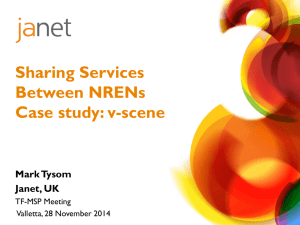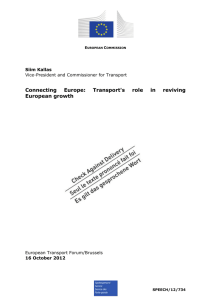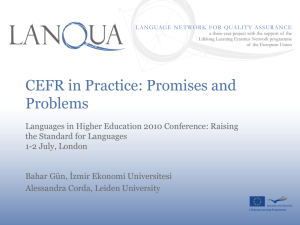CEF or BB4PA and the R&E Networking Community TF-MSP Meeting
advertisement

TF-MSP Meeting Alcala de Henaers, Spain 6/7 May 2013 John DYER dyer@terena.org www.terena.org CEF or BB4PA and the R&E Networking Community The Reason for this Discussion › The EC want CEF – BB4PA to happen › The EC are rightly proud of GÉANT › Opportunity or not for R&E to consider? › Does R&E networking community want: › to be intimately involved ›and if so in what way? › to distance itself from CEF/BB4PA ›and why? › to take some other stance Slide: 2 Background of CEF / BB4PA › President: José Manuel Durão Barroso › 19 Oct 2011: Press Conference, Brussels › Kostas Glinos: Head of Unit DG-CNECT › 26 Oct 2011: Presentation at TERENA GA › Links › www.terena.org/tf-msp/documents/ecpublic/ › Running period for CEF: 2014 – 2020 › In addition to Horizon 2020 funding envelope Slide 3 The Connecting Europe Facility (CEF) Initial Ideas (2011) › Transport 31.7 billion Euros (inc. cohesion fund 10 billion) › Energy 9.1 billion Euros › Key Digital Infrastructure 9.2 billion Euros › TOTAL: 50 billion Euros Slide 4 The Connecting Europe Facility (CEF) after Council Decisions 8 February EUCO37/13 › Transport 31.7 billion 23.174 billion › Energy 9.1 billion 5.126 billion › Key Digital Infrastructure 9.2 billion 1.0 billion › TOTAL: Slide 5 50 billion 29.299 billion Key Digital Service Infrastructures › Total Investment in key DSI ~ 9 billion 1 billion › Broadband 7 billion › encourage local companies to improve connectivity for European citizens: 30 Mbps minimum at least 50% at 100 Mbps ZERO Slide 6 What is currently known about DSI funding › information on the use of this 1billion € is speculation › Priorities will be decided in June 2013 › The 1 billion DIS initiative may cover: › the backbone for Public Administration › other projects ranging from e-government to e-health, europeana etc › synergies with Horizon 2020 (e.g. GÉANT) is certainly encouraged Slide 7 Why a Backbone for Public Administration? › › › › › Global Economic Crisis Public Admin costs need to be reduced Duplication of Infrastructure – Wasteful GÉANT is seen as an excellent model US Unified Community Anchor Network (UCAN) Justice HEALTH CULTURE Slide 8 Three Possible Scenarios amongst others . . . ? Slide 9 Scenario 1 Full Integration with NRENs BB4PA ≡ GÉANT › CEF exchange is integrated into the NREN backbone › Public Administration sites are connected to NREN backbone › The European Backbone for Public Administrations connects all NRENs Slide 10 Scenario 2 Parallel BB4PA/GÉANT BB4PA › CEF Exchanges connect Public Administration Networks › GÉANT connects NRENs as now › Parallel operation does not bring many benefits and synergies GÉANT Slide 11 Scenario 3 CEF Open Exchanges BB4PA › CEF Open Exchanges in each country › NRENs connect to BB4PA through the CEF Open Exchanges Slide 12 Scenario 3 - variations GÉANT ? › Logical Segmentation › Optical Segmentation › Physical Segmentation Slide 13 Strategy for CEF/BB4PA › Study of the readiness of Member States for a common pan-European network infrastructure for public services › Contract to: Capgemini/Deloitte consortium (runs Dec 2012 – Dec 2013) › Establish a Knowledge Base › Analysis of Current Situation › Outreach and Dissemination › Scenarios and Recommendations Slide 14 Timeline Scenarios Contract Awarded Inception Meeting EC Dec 12 Jan 13 TF-MSP NRENPC Start: end June Create Knowledg e Base Interim Report Analysis Apr/May 13 TERENA GA CEF DISCUSS Engagement Discussion platform OPEN TNC BoF 3 June 18:00-19:30 Study Conference TERENA GA 6/7 June Final Report Slide: 15 30/31 Oct Brussels t.b.c Dec 2013 Progress as of 23 April 2013 Interviews carried out: − 8 Reference Networks: • • − 4 Network Service Providers: • › Carried out (4): STORK (eID), epSOS (eHealth), CCN (DG TAXUD) and CISE (DG MARE) 4 Public Administrations: • Awaiting confirmation (4): United Kingdom (Government Secure Intranet), Belgium (Federal Service Bus), Estonia (EEBone / X-Road Middleware), Greece (National Public Administration Network (SYZEFXIS)) and Germany (back-up) (Federal Administration Information Network (IVBV)) 4 Digital Service Infrastructures: • › Carried out (6): Belgium (Public Services Network &NREN), United Kingdom (NREN), Denmark (NREN & part of NorduNet), Hungary (Public Services Network & NREN), Croatia (Public Services Network & NREN) and Internet2 (Third country – USA) Awaiting confirmation (2): Dante (Reference Network) and Germany (NREN) Awaiting confirmation (4): United Kingdom (eBusiness), Belgium (Security - Police), Estonia (eBusiness and eJustice), Hungary (eHealth) and Germany (back-up) (eProcurement) All surveys have been sent out to a total of over 180 respondents. Preliminary Insights NRENs as of 23 April 2013 Two groups with opposite opinions on connecting the Public Administrations to the NRENs: › In Belgium, Croatia, and Denmark NRENs are enthusiastic about connecting Public Administrations. › Other NRENs, like Janet in the UK and Internet2 in the USA, fear losing focus on the primary goal of the network, and a too politicized environment. There is a difference between Western and Eastern Europe. NRENs from the eastern countries fear a further ‘Digital Divide’. NRENs are highly dependent on funding from the government or other sources. Countries, except Denmark, do not face problems when new institutions ask to be connected to the network. Up-scaling bandwidth is no problem except when reaching physical boundaries. Large investments are needed. Only when the NRENs provide services themselves, they do guarantee the safety and security of the data related to these services. Otherwise the users are responsible for their own data. Most of the NRENs state that the requirements of the PAs are low. Belnet is an exception. Most of the NRENs are increasingly focusing on providing cloud services to their clients Preliminary Insights DSIs (CISE, CCN, epSOS, STORK) as of 23 April 2013 all see advantages in using a backbone network, mainly for: › Availability & Security They however have some general concerns: › How will the network be governed? › Is the data on the network secure, since it will also be used by universities and public administrations? › Can the availability be assured when all the public administrations are also connected? There is some cooperation between the different DSIs or there is interest in it. E.g. one of the user communities of CISE is taxation, so they will need to cooperate with CCN. STORK can also be used by the other DSIs. Since they are mostly pilot projects, their use is currently quite low. However, they all see it increasing to a full infrastructure in the future. The funding of the DSIs is mainly done in two ways. The Commission funds the creation of the cross border services (Core Service Platforms), while the Member States are responsible for the internal infrastructure to be able to use them (Generic Services). Cloud adoption is quite low in the DSIs that were interviewed. Community Influence › 32 stakeholders will be interviewed › 12 RN; 5 PA; 4 NSP; 8 DSI › 180 questionnaire invite sent out › all EU NRENs (2) plus DANTE; TERENA . . . . › DSI; NSP; PA; NCP & CIO . . . . › Open TNC BoF: › Contractors will present the work so far › Discussion and Feedback › Can we build consensus? REGISTER NOW Community Information Sources › Documentation › TF-MSP Document Store: › www.terena.org/tf-msp/documents/ecpublic › Private Discussion Wiki for Community › https://confluence.terena.org › username / password from John/Magda › Open email distribution list › cef-discuss@terena.org › Self subscribe at: › www.terena.org/mailinglists.php › Open TNC-BoF Monday 3 June 18:00 – 19:30 › https://tnc2013.terena.org/core/event/9 REGISTER NOW



